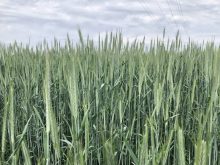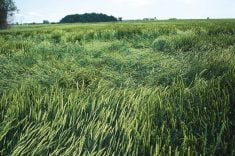Get ready for a new generation of fall rye varieties that are high yielding, have high milling quality and perform well across a wide range of soil types and moistures conditions.
Hybrid fall rye varieties that promise much more yield and market potential than the traditional open-pollenated varieties have become available to Western Canadian farmers in the past couple years. Developed by KWS a German plant breeding company two leading hybrid ryes have been licenced to prairie seed companies — Brassetto hybrid fall rye marketed by FP Genetics and Guttino hybrid fall rye marketed through the southern Alberta SeedNet group of companies.
Read Also

Claas brings 1000 Series SP forage harvesters to Canada
In mid-August, Claas unveiled its new line of Jaguar forage harvesters at an event in Visalia, California, deep in the heart of that state’s dairy region.
“It’s a higher management fall rye,” says Greg Stamp, who’s family-owned Stamp Seed is producing and marketing Guttino seed on their farm at Enchant north of Lethbridge. “But at the same time it has potential for much higher return over a conventional fall rye.”
With potential for a 30 to 50 per cent yield advantage over open pollinated fall rye, growers of Guttino are producing yields of 130 to 150 bushels per acre. And with high falling numbers (a measure of milling quality) it is rye in strong demand for milling and distilling purposes, and even performs well as a high tonnage silage crop — less expensive to grow than corn, but with feed quality very similar to feed barley.
Stamp, who produces a wide range of cereal, pulse crop and other specialty crop seeds says they have been extremely impressed with the consistent performance of the hybrid fall rye on their southern Alberta farm.
“It grows well under irrigation, but it also seems to handle stress very well so it appears to have a wide range of adaptability across Western Canada,” says Stamp.

While it is similar to growing winter wheat and some other winter cereals, the hybrid fall rye has some specific differences as well, says Stamp.
Similar to corn and soybeans, the fully treated seed is sold on a unit basis (one unit being one million viable seeds). The seeding rate for Guttino is 0.8 of a unit, or 800,000 viable seeds per acre. “It roughly works out to about 70 to 80 pounds of seed per acre,” says Stamp. But the objective is to seed 800,000 viable seeds per acre, targeting 18 plants per square foot.
With higher seed cost and higher fertility requirements to optimize the yield potential, Stamp says it is probably similar to hybrid canola in input and production costs.
Stamp applies a glyphosate or Prepass burndown application prior to seeding the hybrid fall rye during the usual September seeding window. Because the crop gets off to a very early start in the spring, nitrogen is fall banded as well. Guttino is a very winter hardy, and the fully treated seed appears to help it withstand many common disease pressures. Due to its growth physiology the hybrid fall rye appears to be less affected by fusarium head blight.
While in-crop herbicides may be needed in spring to control broadleaf weeds, the hybrid fall rye appears to be very effective in suppressing and controlling wild oats on its own. “On fields where we are growing the hybrid fall rye, we don’t see any wild oats, even though they may have been a problem in the past,” says Stamp.
The crop heads out in about mid-May and is ready for harvest in late July. While the hybrid fall rye, with excellent milling quality, appears to be in high demand, the SeedNet group is looking at developing market connections for their hybrid fall rye producers.
For more information on Guttino hybrid rye visit the Stamp Seeds website.
















